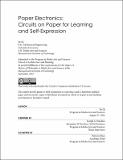| dc.contributor.advisor | Joseph A. Paradiso. | en_US |
| dc.contributor.author | Qi, Jie | en_US |
| dc.contributor.other | Program in Media Arts and Sciences (Massachusetts Institute of Technology) | en_US |
| dc.date.accessioned | 2017-06-06T18:44:33Z | |
| dc.date.available | 2017-06-06T18:44:33Z | |
| dc.date.issued | 2016 | en_US |
| dc.identifier.uri | http://hdl.handle.net/1721.1/109617 | |
| dc.description | Thesis: Ph. D., Massachusetts Institute of Technology, School of Architecture and Planning, Program in Media Arts and Sciences, 2016. | en_US |
| dc.description | This electronic version was submitted by the student author. The certified thesis is available in the Institute Archives and Special Collections. | en_US |
| dc.description | "September 2016." Cataloged from student-submitted PDF version of thesis. | en_US |
| dc.description | Includes bibliographical references (pages 148-156). | en_US |
| dc.description.abstract | In this dissertation, I explore the theme of wonder in technology, learning and self-expression through the lens of paper electronics, which is circuit building on paper using conductive tapes and circuit components as electronic craft materials. This new medium blends the interactive functionality of electronics with the expressive flexibility of the paper medium. I present an overview of the paper electronics medium as well as its extension in the form of electrified books, books with circuitry integrated with its pages and spine. I then described the design of a paper electronics toolkit called circuit stickers and how this toolkit was deployed through a company called Chibitronics. Finally, through the circuit stickers toolkit, I investigate and evaluate the paper electronics medium as a learning tool and approach, expressive medium and method to engage more diverse communities in technology creation. These investigations show that paper electronics has indeed impacted learners, educators and creators across many backgrounds and disciplines. It has enabled educators to teach a broad range of subjects and skills in new ways. Artists have used paper electronics to explore electricity and interactivity for self-expression, demonstrating the aesthetic flexibility and expressive potency of this medium. Finally, it has engaged creators from diverse communities and backgrounds including educators, Makers, and crafters. It enables not only new approaches to learning and creating technology, it also engages new types of creators in inventing surprising technological artifacts--ones that inspire new experiences, objects and opportunities for wonder. | en_US |
| dc.description.statementofresponsibility | by Jie Qi. | en_US |
| dc.format.extent | 217 pages | en_US |
| dc.language.iso | eng | en_US |
| dc.publisher | Massachusetts Institute of Technology | en_US |
| dc.rights | MIT theses are protected by copyright. They may be viewed, downloaded, or printed from this source but further reproduction or distribution in any format is prohibited without written permission. | en_US |
| dc.rights.uri | http://dspace.mit.edu/handle/1721.1/7582 | en_US |
| dc.subject | Program in Media Arts and Sciences () | en_US |
| dc.title | Paper electronics : circuits on paper for learning and self-expression | en_US |
| dc.title.alternative | Circuits on paper for learning and self-expression | en_US |
| dc.type | Thesis | en_US |
| dc.description.degree | Ph. D. | en_US |
| dc.contributor.department | Program in Media Arts and Sciences (Massachusetts Institute of Technology) | en_US |
| dc.identifier.oclc | 988750309 | en_US |
